 Scot Braithwaite was instrumental in applying Wellard Rural Exports “big ship” model to the South East Asian cattle trade in the mid-2000s, which saw the company grow to become Australia’s largest cattle exporter. Following his departure from the now publicly listed company earlier this month, Beef Central spoke to the Indonesian based exporter about his 40 years in the industry so far, his views on the current state of play and what he believes recent reviews and a new wave of regulation will mean for the trade.
Scot Braithwaite was instrumental in applying Wellard Rural Exports “big ship” model to the South East Asian cattle trade in the mid-2000s, which saw the company grow to become Australia’s largest cattle exporter. Following his departure from the now publicly listed company earlier this month, Beef Central spoke to the Indonesian based exporter about his 40 years in the industry so far, his views on the current state of play and what he believes recent reviews and a new wave of regulation will mean for the trade.
SCOT Braithwaite was 10 years old when his father moved the family from western Queensland to western Malaysia in the early 1970s to start a cattle breeding operation half way between Kuala Lumpur and Singapore.
There they established one of the early feedlots in Asia, weaning cattle from paddocks into a feedlot feeding palm kernel cake (cake), an abundant by-product of the palm oil industry.
The project ran successfully until Malaysia opened its market to imports of Indian Buffalo meat in return for India opening its market to imports of Malaysian palm oil.
The resulting flood of cheap Indian meat that entered Malaysia severely disrupted the market for locally fed cattle, a portent of what Mr Braithwaite would experience again in Indonesia some 40 years later.
In those intervening years Mr Braithwaite has sold close to three million Australian cattle, a figure few would have matched in the industry’s history, expedited by the role he played in helping Wellard Rural Exports to introduce the big 20,000 head ships to South East Asia in the mid-2000s.
In the years after boarding school in Toowoomba Mr Braithwaite worked with several major cattle companies in western Queensland and Northern Territory including Austrex, Stanbroke and Heytesbury, some how finding time in stock camps along the way to complete an economics degree externally through the University of Queensland.
In the mid-1990s he moved to Indonesia and, with three ex-Heytesbury colleagues, established a cattle exporting business, SEAF. The business operated through the Asian economic crisis and was eventually sold to Santori, now one of Indonesia’s largest cattle importers and feeders.
Pioneering the big ship model
In 2004 Wellard Rural Exports was exporting sheep to the Middle East with the world’s largest purpose-built livestock carrier, the Ocean Drover, but was looking for other runs for the vessel between the peak annual demand periods in the Middle East of Eid il Fitr and Hajj.
Indonesia had emerged by then as a large and growing market for Australian cattle, taking 300,000 cattle a year in small shipments of 2000 to 3000 head at a time.
Mr Braithwaite was confident the market could handle much larger one-off shipments of 15,000-20,000 head, which the Drover could supply.
“Mauro (Wellard owner Mauro Balzarini) said to me people told him it couldn’t work, but I said I think it can, and I think it is a viable way to move cattle especially if the price is right and especially if you can bring Townsville closer to Darwin,” Mr Braithwaite said.
“If you can have a Townsville-Darwin load it makes it viable, it makes sense to everybody, I thought we could make that work.”
Mr Braithwaite said producers in northern Queensland also welcomed the additional market diversification opportunity provided by the bigger ships to sell cattle, particularly in dry seasons (see seperate story – Why live export is the greatest drought strategy Australia has)
“With the economics of running the big boats we had some advantage in pricing, and when the customers realised how well they travel (on the large vessels), and that it was quite easy to add extra numbers, we started shipping a lot of cattle to Indonesia.”
In June 2011 Mr Braithwaite became an unofficial spokesperson for the trade when a letter he wrote explaining the considerable investments made by the industry in improving welfare standards in Indonesia, and questioning why those developments were glossed over or ignored by the ABC Four Corners report that triggered the trade’s suspension, attracted viral mainstream and social media interest (see letter here)
Seven years later, he describes that dramatic upheaval and the subsequent introduction of ESCAS as the ‘wake up call’ the trade needed to accelerate the uptake of higher animal welfare standards, including pre-slaughter stunning, in a much faster way than would have otherwise been possible.
Wellard departure
Asked why he recently decided to part ways with Wellard after 14 years, Mr Braithwaite pointed to directional changes following the company’s December 2015 public listing.
Following successive annual losses Wellard recently announced a shift in focus toward increased chartering of its vessels to other users and reducing its own trading activities in the current market environment.
Mr Braithwaite said there was a tendency when companies were publicly listed for ‘accountants to rise to the top’ which in his view did not suit trading companies.
“Trading is all about decision making, and if there is a lapse in the decision making, I can tell you, the competitors are in there very quickly and make life very, very difficult.
“Accountants hate risk, it is just the way they are born, and they think if they can pull all the risk out of things then things will be fine, but live exports and trading is inherently risky.”
Mr Braithwaite said the company’s strategy of finding charter customers to keep vessels optimally utilised could be challenging in the current global environment, with economic issues in the major market of Turkey in particular causing cutbacks in exports to that market and spare shipping capacity.
Indian buffalo meat
Indonesia remains the number one market for Australian cattle by a country mile and, despite the disruptions caused in the past two years by the introduction of cheap frozen Indian buffalo meat, Mr Braithwaite believes there are reasons for Australia producers to be optimistic about the market’s long-term future.
Mr Braithwaite said the pendulum had swung very much in favour of cheap Indian buffalo meat in the market in recent years, helped by the high price of Australian cattle, but there are signs the market is starting to settle and that fresh meat will always have a place.
“There are guys who were buying Indian meat who are coming back to buying fresh meat, just because it didn’t suit the purpose for what they were using it for,” he said.
“The market still doesn’t want meat that is cold, the wet market wants to buy meat that is warm to touch, and people are still willing to pay that premium, which is $2-3/kg depending on where you are.
“If the feedlotters can bring their price back to a point where it is consistently at that and they can supply consistently at that, and you know we’ll go back to 750,000 or 800,000 a year.
“While it (the price of fed price) is over and above that, we’ll do 500,000 or whatever it is, 550,000 a year.”
Indonesian breeder import policy
Another issue that is dominating trade attentions leading into the final months of the year is the question of whether the Indonesian Government will seek on December 31 to enforce the ‘five to one’ feeder to breeder cattle import ratio policy it announced last year.
With the high price of breeding cattle from Australia and the lack of infrastructure to support breeding operations, no importer has been able to meet the requirement to buy in breeders as 20pc of their total import volumes. The December 2018 deadline originally nominated by the Indonesian Government as the audit date is fast approaching.
There has been very little clarity as to what will happen but Mr Braithwaite said it appears that the Indonesian Government may instead be moving to a policy that would require importers to dedicate five percent of their feedlot capacity to breeding cattle in future, to support the country’s aspirations to become self-sufficient in breeding cattle.
“It has changed many times and we do have an election next year which can change the dynamics again, so we will have to see what that brings.”
Indonesian customers ‘a major asset’ for northern producers
Mr Braithwaite said a major advantage northern Australian cattle producers who relied on live export had was the tenacity of their remaining feedlot customers in Indonesia.
“They are a battle hardened group of guys who have had to handle far more than we probably ever have in Australia,” Mr Braithwaite said.
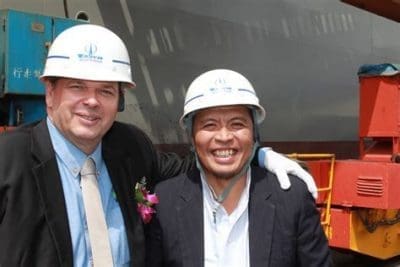
Scott Braithwaite with long term Indonesian feedlot customer Hafid Wahyu from Agri Satwa at the launch of Wellard’s Ocean Shearer in China in 2016.
“With Government regulations – one minute you have 20pc of your numbers you have to bring in and have got to be females, restrictions on import permits, restrictions on weights – then they have got the police coming in and checking their sales, accused of being a monopoly, and then they have the high price in Australia and the ESCAS issues.
“You know these guys who are left, you would have to say they are very hard core clients for Australian cattle and I don’t believe we probably take their requirements into account enough in our breeding and what we’re doing.
“I think there’s plenty of opportunity to improve what we do in Australia to assist the guys over here with genetics and R&D and all sorts of things, we’re not doing enough with our genetics to work on what cattle do well in a tropical environment, 98 percent humidity, eating by product rations.”
Australia needs to be a better neighbour
Mr Braithwaite said Australians vastly underestimated how damaging politically-motivated comments such as Katter Australia Party candidate Fraser Anning’s anti-immigration speech earlier this year or Prime Minister Scott Morrison’s out-of-the-blue Wentworth by-election call to move the Australian embassy to Jerusalem affected Australia’s standing in Indonesia.
Indonesia is a strong supporter of Palestine and those comments have now lead to Indonesia holding off signing a free trade deal (IA CEPA) between the two countries.
“How many people in Australia would actually think about that (shifting the embassy), yet the effect over here of those comments was actually quite dramatic,” Mr Braithwaite said.
“If that is the way your neighbour is going to do for what little gain, it is looked upon quite abnormally, that is not something your next door neighbour does.”
In his view Australia should be embracing Indonesia as a source of hard-working employees as a solution to the agricultural labour shortage problem, and develop a special visa to allow Indonesian workers to be trained and work here and send money back to support their families at home.
“There is such a shortage of labour in rural Australia, it is a way for us to be a good neighbour,” he said. “Much better than using over paid backpackers from western countries, we should be thinking about ways we can integrate our neighbours and help them.”
How reviews will impact trade
Some big changes are now being made to how the Australian livestock industry operates following three separate reviews this year – the McCarthy Review, Moss Review and a long overdue review of the Australian Standards for the Export of Livestock.
Following the reviews exporters will have to keep stock in pre-export quarantine for longer periods, reduce stocking densities on ships, have more stockmen and women per voyage, pay for independent observers or all or most voyages, and face lower reportable mortality rates.
Mr Braithwaite said he thinks the changes will make it harder for smaller exporters to operate viably.
“I think you are going to have to do volume to cover your costs,” he said.
“It is going to increase your overhead just by having to have people tick the right boxes.”
He said he doubted the changes would have a beneficial effect on short haul trade which was already operating with very high animal welfare standards and low mortality rates.
“I think the short haul trade into South East Asia has done remarkably well with regard to animal welfare and reducing mortality rates.
“We did 19,000 the other day and lost 12, that is 0.001 percent, and that is probably what the industry average is now.
“You would lose more cattle on a truck trucking them down to the channels or to an abattoir from the Barkly.”
China trade will grow
Mr Braithwaite said he believes China will become a large export market for Australian cattle, but would only become so when China allows lighter feeder cattle from Australia to be imported.
He said the combination of the high price of cattle in China, the huge volumes of by product available as a cattle feed, such as soybean waste, and the strong food safety reputation of Australian cattle, presented an excellent long-term trade opportunity when China lifted restrictions that currently preventing feeder imports. But he predicted that may still be a couple of years from happening yet.
Enjoying a rare wet season break
After his recent decision to leave Wellard, Mr Braithwaite said he is enjoying the prospect of spending his first wet season in 27 years not having to source cattle.
“Finding the cattle people need in December, January and February, and at a price they can afford to pay, has always been the greatest challenge you face,” he said.
“When it is raining and there is green grass people don’t want to sell you a 300kg steer.
“When the floodplain became more organised and people started to put cattle away, it just became more competitive, because people knew they were there and paid a lot of money for them, and you had to then try to talk the guys in Indonesia to pay that price.
“It has always been most challenging part of the business. I have a 12 month non-compete (contract) so I am certainly going to enjoy not having to sell cattle in a wet season for the first time in 27 years.”
Asked about his own future Mr Braithwaite said he currently had no firm plans as to what he will do when his 12 month non-compete clause concludes in October next year.

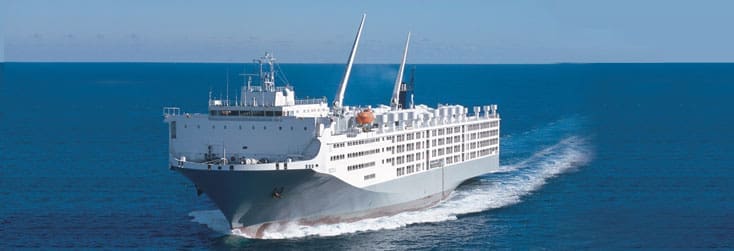
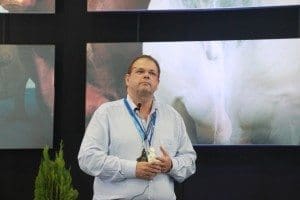
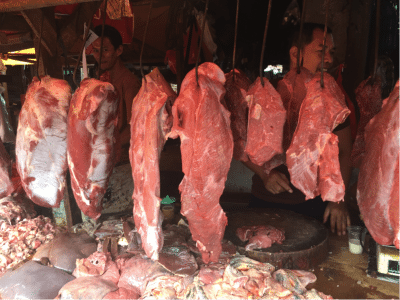
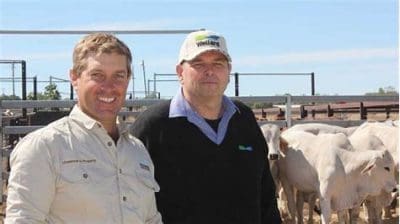
An outstanding live export leader Many thanks
Well done Scot. We admire the intelligence and hard work you have applied to a broad view of the cattle industry in more than two countries. We have enjoyed watching your progress from a start as a very capable jackeroo at Bowen Downs in 1982 through your many experiences, and look forward to your next ventures. All the best from us all.
I have known Scot for more than 20 years and had the privilege of working with him for the past 10. He was also instrumental in rolling out ESCAS to clients across Indonesia after the suspension to the trade in 2011 and had the courage to “drop” clients/importers who would not accept pre-slaughter stunning. Scot is an outstanding ambassador for Australian livestock who has refused to compromise on animal welfare during transport and in-market. He is a true leader within the livestock export industry. Thanks for your friendship and commitment to the business and I am sure you will be missed by your former employer.
Congratulations you have come a long way since running the camp at Auvergne,
Best wishes Scot.